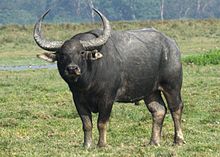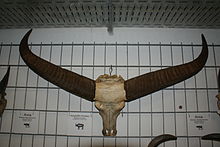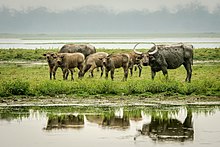Wild water buffalo
| Wild water buffalo | |
|---|---|

| |
| in Kaziranga National Park | |
| Scientific classification | |
| Domain: | Eukaryota |
| Kingdom: | Animalia |
| Phylum: | Chordata |
| Class: | Mammalia |
| Order: | Artiodactyla |
| Family: | Bovidae |
| Subfamily: | Bovinae |
| Genus: | Bubalus |
| Species: | B. arnee
|
| Binomial name | |
| Bubalus arnee (Kerr, 1792)
| |
| Subspecies | |
| |

| |
| Wild water buffalo range | |
| Synonyms | |
|
Bubalus bubalis arnee | |
The wild water buffalo (Bubalus arnee), also called Asian buffalo, Asiatic buffalo and wild buffalo, is a large bovine native to the Indian subcontinent and Southeast Asia. It has been listed as Endangered in the IUCN Red List since 1986, as the remaining population totals less than 4,000. A population decline of at least 50% over the last three generations (24–30 years)[when?] is projected to continue.[2] The global population has been estimated at 3,400 individuals, of which 3,100 (91%) live in India, mostly in Assam.[3] The wild water buffalo is the most likely ancestor of the domestic water buffalo.[4][5]
Taxonomy

Bos arnee was the
In 2003, the
Only a few
Characteristics

The wild water buffalo has an ash-gray to black skin. The moderately long, coarse and sparse hair is directed forward from the haunches to the long and narrow head. There is a tuft on the forehead, and the ears are comparatively small. Its head-to-body-length is 240 to 300 cm (94 to 118 in) with a 60 to 100 cm (24 to 39 in) long tail and a shoulder height of 150 to 190 cm (59 to 75 in). Both sexes carry horns that are heavy at the base and widely spreading up to 2 m (79 in) along the outer edges, exceeding in size the horns of any other living
Distribution and habitat

The wild water buffalo occurs in India, Nepal, Bhutan, Thailand, and Cambodia, with an unconfirmed population in Myanmar. It has been extirpated in Bangladesh, Laos, Vietnam, and Sri Lanka.[2][3] It is associated with wet grasslands, swamps, flood plains and densely vegetated river valleys.[2]
In India, it is largely restricted to in and around
Many surviving populations are thought to have interbred with feral or domestic water buffaloes. In the late 1980s, fewer than 100 wild water buffaloes were left in Madhya Pradesh.[21] By 1992, only 50 animals were estimated to have survived there.[20]
Nepal's only population lives in Koshi Tappu Wildlife Reserve and has grown from 63 individuals in 1976 to 219 individuals in 2009.[22] In 2016, 18 individuals were translocated from Koshi Tappu Wildlife Reserve to Chitwan National Park.[23]
In and around Bhutan's Royal Manas National Park, a small number of wild water buffaloes occur. This is part of the sub-population that occurs in India's Manas National Park.[3] In Myanmar, a few animals live in Hukaung Valley Wildlife Sanctuary.[2]
In Thailand, wild water buffaloes have been reported to occur in small herds of less than 40 individuals. A population of 25–60 individuals inhabited lowland areas of the Huai Kha Khaeng Wildlife Sanctuary between December 1999 and April 2001. This population has not grown significantly in 15 years, and is maybe interbreeding with domestic water buffaloes.[24]
The population in Cambodia is confined to a small area of easternmost
The wild water buffaloes in Sri Lanka are thought to be descendants of the introduced domestic water buffalo. It is unlikely that any true wild water buffaloes remain there today.[2]
Wild-living populations found elsewhere in Asia, Australia, Argentina and Bolivia are feral domestic water buffaloes.[15]
Ecology and behavior
Wild water buffaloes are both
They are probably
Tigers and mugger crocodiles prey on adult wild water buffaloes, and Asian black bears have also been known to kill them.[28]
Threats
A population reduction by at least 50% over the last three generations seems likely given the severity of the threats, especially hybridization; this population trend is projected to continue into the future. The most important threats are:[2]
- interbreedingwith feral and domestic water buffaloes in and around protected areas;
- hunting, especially in Thailand, Cambodia, and Myanmar;
- habitat loss of floodplain areas due to conversion to agriculture and hydropower development;
- degradation of wetlands due to invasive species such as stem twiners and lianas;
- diseases and parasitestransmitted by domestic livestock;
- interspecific competition for food and water between wild water buffaloes and livestock.
Conservation
Bubalus arnee is included in
In 2017, 15 wild water buffaloes were
References
- PMID 27667928.)
{{cite journal}}: CS1 maint: multiple names: authors list (link - ^ . Retrieved 17 January 2024.
- ^ a b c d e Choudhury, A. (2010). The vanishing herds: the wild water buffalo. Gibbon Books, Rhino Foundation, CEPF & COA, Taiwan, Guwahati, India.
- PMID 9745663.
- ^ Groves, C. P. (2006). "Domesticated and Commensal Mammals of Austronesia and Their Histories". In Bellwood, P.; Fox, J. J.; Tryon, D. (eds.). The Austranesians. Canberra: Research School of Pacific Studies, The Australian National University. pp. 161–176.
- ^ Kerr, R. (1792). "Arnee Bos arnee". The Animal Kingdom or zoological system of the celebrated Sir Charles Linnaeus. Class I. Mammalia. Edinburgh & London: A. Strahan & T. Cadell. p. 336.
- ISBN 9781681084176– via Google Books.
- ^ "Definition of ARNA". www.merriam-webster.com.
- ^ Smith, C. H. (1827). "Sub-genus I. Bubalus". In Griffith, E. (ed.). The animal kingdom arranged in conformity with its organization. Vol. 5. Class Mammalia. London: Geo. B. Whittaker. pp. 371–373.
- ^ Ellerman, J. R.; Morrison-Scott, T. C. S. (1966). "Genus Bubalus H. Smith, 1827". Checklist of Palaearctic and Indian mammals 1758 to 1946 (Second ed.). London: British Museum of Natural History. pp. 383–384.
- ^ International Commission on Zoological Nomenclature (2003). "Opinion 2027 (Case 3010). Usage of 17 specific names based on wild species which are pre-dated by or contemporary with those based on domestic animals (Lepidoptera, Osteichthyes, Mammalia)". The Bulletin of Zoological Nomenclature. 60 (1): 81–84.
- .
- S2CID 84855572.
- .
- ^ ISBN 9780801857898.
- ^ Aryal, A.; Shrestha, T.K.; Ram, A.; Frey, W.; Groves, C.; Hemmer, H.; Dhakal, M.; Koirala, R.J.; Heinen, J.; Raubenheimer, D. (2011). "Call to conserve the Wild Water Buffalo (Bubalus arnee) in Nepal" (PDF). International Journal of Conservation Science. 2 (4): 261–268.
- ISBN 9789401775700.
- S2CID 13441339.
- ISBN 9781400834112.
- ^ .
- ^ Divekar, H. K. & Bhusan, B. (1988). Status of wild Asiatic buffalo (Bubalus bubalis) in the Raipur and Bastar Districts of Madhya Pradesh (Report). Technical Report of the Bombay Natural History Society of the Salim Ali Nature Conservation Fund, SANCF Report No. 3/1988.
- hdl:2027.42/31022.
- .
- ^ Chaiyarat, R.; Lauhachinda, V.; Kutintara, U.; Bhumpakphan, N.; Prayurasiddhi, T. (2004). "Population of Wild Water Buffalo (Bubalus bubalis) in Huai Kha Khaeng Wildlife Sanctuary, Thailand" (PDF). Natural History Bulletin Siam Society. 52 (2): 151–162. Archived from the original (PDF) on 2011-07-28. Retrieved 2011-03-24.
- ^ Tordoff, A. W., Timmins, R. J., Maxwell, A., Huy Keavuth, Lic Vuthy and Khou Eang Hourt (eds). (2005). Biological assessment of the Lower Mekong Dry Forests Ecoregion. WWF Greater Mekong Programme. Phnom Penh, Cambodia
- ^ Daniel J. C., Grubh B. R. (1966). "The Indian wild buffalo Bubalus bubalis (Linn), in peninsular India: a preliminary survey". Journal of the Bombay Natural History Society. 63: 32–53.
- ^ Lēkhakun, B., Mcneely, J. A. (1988). Mammals of Thailand. 2nd edition. Saha Karn Bhaet, Bangkok, Thailand
- ISBN 1-877743-05-4
- S2CID 216528987.
External links
- IUCN Asian Wild Cattle Specialist Group: Water buffalo (Bubalus arnee)
- Wild Cattle Conservation Project
- Animal Info: Wild water buffalo
- Wildlife Trust of India February 2006: Wild buffalo faces extinction
- The Hindu February 2006: Project to conserve wild Asian buffalo

